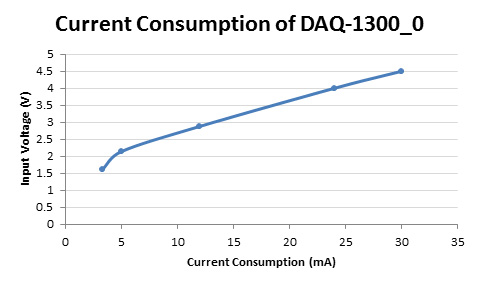DAQ1300 User Guide
Getting Started
Welcome to the DAQ1300 user guide! In order to get started, make sure you have the following hardware on hand:
- DAQ1300 - 4x Isolated Digital Input Phidget
- VINT Hub
- Phidget cable
- USB cable and computer
- something to use with the DAQ1300 (e.g. switch, digital sensor with a digital output, etc.)
Next, you will need to connect the pieces:

- Connect the DAQ1300 to the VINT Hub using the Phidget cable.
- Connect the VINT Hub to your computer with a USB cable.
- Connect a switch or digital sensor to one of the DAQ1300's inputs.
Now that you have everything together, let's start using the DAQ1300!
Using the DAQ1300
Phidget Control Panel
In order to demonstrate the functionality of the DAQ1300, the Phidget Control Panel running on a Windows machine will be used.
The Phidget Control Panel is available for use on both macOS and Windows machines.
Windows
To open the Phidget Control Panel on Windows, find the ![]() icon in the taskbar. If it is not there, open up the start menu and search for Phidget Control Panel
icon in the taskbar. If it is not there, open up the start menu and search for Phidget Control Panel
macOS
To open the Phidget Control Panel on macOS, open Finder and navigate to the Phidget Control Panel in the Applications list. Double click on the ![]() icon to bring up the Phidget Control Panel.
icon to bring up the Phidget Control Panel.
For more information, take a look at the getting started guide for your operating system:
Linux users can follow the getting started with Linux guide and continue reading here for more information about the DAQ1300.
First Look
After plugging the DAQ1300 into your computer and opening the Phidget Control Panel, you will see something like this:
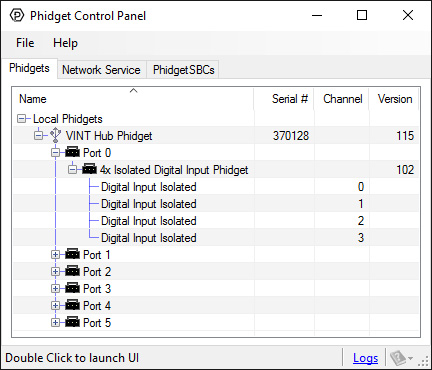
The Phidget Control Panel will list all connected Phidgets and associated objects, as well as the following information:
- Serial number: allows you to differentiate between similar Phidgets.
- Channel: allows you to differentiate between similar objects on a Phidget.
- Version number: corresponds to the firmware version your Phidget is running. If your Phidget is listed in red, your firmware is out of date. Update the firmware by double-clicking the entry.
The Phidget Control Panel can also be used to test your device. Double-clicking on an object will open an example.
Digital Input
Double-click on a Digital Input object in order to run the example:
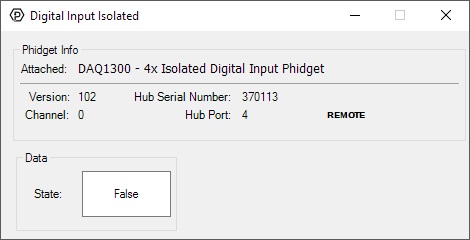
General information about the selected object will be displayed at the top of the window. You can also experiment with the following functionality:
- This is an active-high device, therefore, it will be true when connected to a high voltage, and false when connected to ground.
For more information about Digital Inputs, take a look at the Digital Input Primer
Finding The Addressing Information
Before you can access the device in your own code, and from our examples, you'll need to take note of the addressing parameters for your Phidget. These will indicate how the Phidget is physically connected to your application. For simplicity, these parameters can be found by clicking the button at the top of the Control Panel example for that Phidget.

In the Addressing Information window, the section above the line displays information you will need to connect to your Phidget from any application. In particular, note the Channel Class field as this will be the API you will need to use with your Phidget, and the type of example you should use to get started with it. The section below the line provides information about the network the Phidget is connected on if it is attached remotely. Keep track of these parameters moving forward, as you will need them once you start running our examples or your own code.

Using Your Own Program
You are now ready to start writing your own code for the device. The best way to do that is to start from our the [https://www.phidgets.com/?view=code_samples&class=DigitalInput DigitalInput Examples. Code Samples].
Select your programming language of choice from the drop-down list to get an example for your device. You can use the options provided to further customize the example to best suit your needs.
Once you have your example, you will need to follow the instructions on the page for your programming language to get it running. To find these instructions, select your programming language from the Programming Languages page.
Technical Details
General
The DAQ1300 features four isolated digital input terminals. Each input is isolated from all other inputs, which allows a single device to connect to a variety of sources, and prevents cross-channel interference.
Each input is active-high, meaning the (+) terminal must be pulled at least 2.5 volts above the (-) terminal to register as TRUE.
Example Use
Here are a few things you can do with the DAQ1300 Digital Input Phidget
Use With a Switch
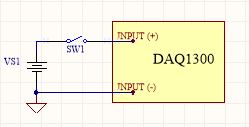
To interface a switch with the DAQ1300, an external voltage source must be provided to pull the input HIGH.
Multiple Sources
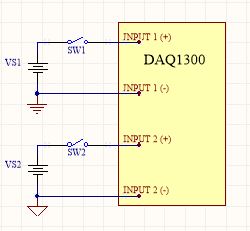
All inputs on the DAQ1300 are isolated from one another, so a variety of signals from different sources can be monitored with a single device.
Detecting an External Voltage
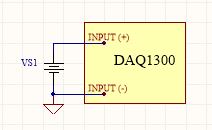
The DAQ1300 can be used without additional circuitry to detect the presence of a voltage on a line (from a power source or a signal), by wiring the input terminals to the line and its corresponding ground.
Digital Input Current
The current consumption of this device varies depending on the voltage applied at the input. It ranges from 1.6mA to 4.5mA, according to the curve below:
